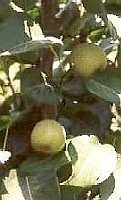View crop
View crop Data sheet EcoPortPyrus pyrifolia
 |
|
| Notes |
|---|
| BRIEF DESCRIPTION A small, erect, sometimes spiny deciduous tree reaching 9-15 m in height. The fruit is a pyriform to subglobose pome, 2-3 cm in diameter in wild forms and up to 15 cm in cultivars, brown, reddish-brown or yellow in colour. USES The fruit is eaten fresh, in fruit salads, canned, dried or candied. The timber can be used for furniture. GROWING PERIOD Perennial. Fruits ripen 4-5 months after blossom. COMMON NAMES Sand pear, Apple pear, Chinese pear, Japanese pear, Asian pear, Oriental pear, Nashi, Poire orientale, Apel jepang, Lai, Peras, Sali, Le. FURTHER INF Scientific synonym: P. serotina, P. sinensis. Sand pear is native of northern-eastern and eastern Asia. Cultivars differ in thier chilling requirements, but generally it needs 250-1000 hours under 7°C to overcome the dormancy period. In the tropics overcast skies during the rainy season and drought reduce the chilling requirements. Protection against wind is important, especially for large fruited cultivars, since the fruit can be damaged even by rubbing against leaves. Frost during flowering and fruit causes considerable crop losses. Most pear cultivars require cross-polination to set good crops. During dormancy the tree is tolerant of drought and flooding. Average annual fruit yields in Japan are 25-40 t/ha and up to 45 t/ha have been obtained. | Sources |
| SOURCES (P. pyrifolia (N.L. Myanmarn f.) Nakai) Roecklein J 1987 pp 237 [USE] Duke J 1975 pp 25 [PH, RAIN, TEMP] Hartmann T 1981 pp 600-601 [KTMP, TEXT, DRA, FER] Verheij E 1991 pp 272-275 [USE, LIG, TEMP, KTMP] |